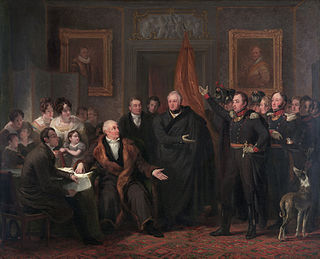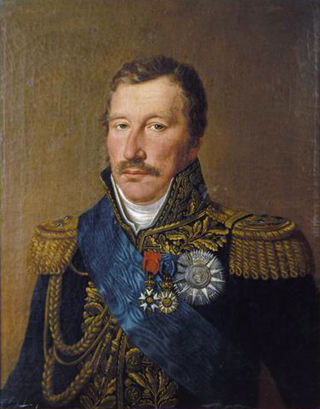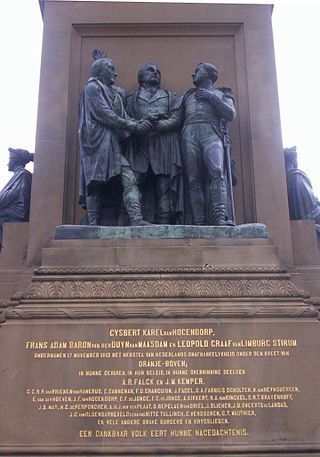| van Hogendorp | |
|---|---|
| noble family | |
 | |
| Country | |
| Founded | 16th century |
| Founder | Gijsbrecht Gillisz van Hogendorp |
| Titles | baron, count, jonkheer |
Van Hogendorp is a patrician family that belongs to the Dutch nobility.
| van Hogendorp | |
|---|---|
| noble family | |
 | |
| Country | |
| Founded | 16th century |
| Founder | Gijsbrecht Gillisz van Hogendorp |
| Titles | baron, count, jonkheer |
Van Hogendorp is a patrician family that belongs to the Dutch nobility.
The first recorded member is the Gijsbert Gillisz. van Hogendorp who died in The Hague in 1584 and worked as a councillor for the High Council of Holland. During the 17th and 18th century the family played a role in the government of Rotterdam.
The possessions of the Van Hogendorp family include the partly free lordships of Moerkapelle, Wilde Veenen, Sint-Jan ten Steen, Glossenberghe, Hofwegen, Steenhuysen, Cromstrijen and Heijningen. In 1748 Gijsbert van Hogendorp was granted the title of Reichsgrave by emperor Francis I. In 1811, emperor Napoleon gave Dirk van Hogendorp the title of Comte de l'Empire . In 1814, Gijsbert Karel van Hogendorp was appointed to the ridderschap (thus de facto recognized into the nobility) and in 1815 granted the title Count of the Kingdom of the Netherlands, with inheritance of the title to the legal, eldest son. In 1867, his younger son Frederik van Hogendorp was granted the title Baron of the Kingdom of the Netherlands, with inheritance of the title to the legal eldest son. This was converted into inheritance of the baronial title on all in 1868. Untitled noble members of other branches of the family still bear the predicate Jonkheer .

Baron is a rank of nobility or title of honour, often hereditary, in various European countries, either current or historical. The female equivalent is baroness. Typically, the title denotes an aristocrat who ranks higher than a lord or knight, but lower than a viscount or count. Often, barons hold their fief – their lands and income – directly from the monarch. Barons are less often the vassals of other nobles. In many kingdoms, they were entitled to wear a smaller form of a crown called a coronet.

The County of Holland was a state of the Holy Roman Empire and from 1433 part of the Burgundian Netherlands, from 1482 part of the Habsburg Netherlands and from 1581 onward the leading province of the Dutch Republic, of which it remained a part until the Batavian Revolution in 1795. The territory of the County of Holland corresponds roughly with the current provinces of North Holland and South Holland in the Netherlands.

The Dutch nobility is a small elite social class constisting of individuals or families recognized as noble, and with or without a title of nobility in the Kingdom of the Netherlands.
Jonkheer is an honorific in the Low Countries denoting the lowest rank within the nobility. In the Netherlands, this in general concerns a prefix used by the untitled nobility. In Belgium, this is the lowest title within the nobility system, recognised by the Court of Cassation. It is the cognate and equivalent of the German noble honorific Junker, which was historically used throughout the German-speaking part of Europe, and to some extent also within Scandinavia.

Gijsbert Karel, Count van Hogendorp was a liberal conservative and liberal Dutch statesman. He was the brother of Dirk van Hogendorp the elder and the father of Dirk van Hogendorp the younger.

Dirk van Hogendorp, comte de l'Empire, was a Dutch officer; colonial administrator; diplomat and Minister of War, for the Kingdom of Holland; and confidant of Napoleon. In 1812 he was governor of Vilnius, in 1813 he was appointed as the governor of Hamburg. He was an early critic of the Dutch colonial system as implemented under the VOC. His ideas about reforms in the Dutch East Indies were to a large extent realized by the Commissioners-General of the Dutch East Indies, through the behind the scenes influence of his friend Herman Warner Muntinghe, first as adviser of Stamford Raffles, and later as adviser of the Commissioners-General.
Hereditary titles, in a general sense, are nobility titles, positions or styles that are hereditary and thus tend or are bound to remain in particular families.

Leopold Count van Limburg Stirum was a politician who was part of the Triumvirate that took power in 1813 in order to re-establish the monarchy in the Netherlands.

The House of Limburg-Stirum, which adopted its name in the 12th century from the immediate county of Limburg an der Lenne in what is now Germany, is one of the oldest families in Europe. It is the eldest and only surviving branch of the House of Berg, which was among the most powerful dynasties in the region of the lower Rhine during the Middle Ages. Some historians link them to an even older dynasty, the Ezzonen, going back to the 9th century.
Dirk, Count van Hogendorp, son of Gijsbert Karel van Hogendorp, nephew of Dirk van Hogendorp, father of Dirk van Hogendorp jr., was a Dutch jurist. Van Hogendorp lived continually in the shadow of his father, the founder of the first Dutch Constitution. He is a great-great-grandfather of Audrey Hepburn.
Gerolf or Gerulf was the second count of this name who is attested in the area of Friesland. Gerolf's main area of power seems to have been in Kennemerland. Count Gerolf is often regarded as the founder of the County of Holland, although the actual name "Holland" is from a later time. His ancestry is unclear, but he may have been a son or, more likely, a grandson of the earlier Gerolf, who was a count in the area of Frisia at the time of the reign of Emperor Louis the Pious and who later joined a monastery. The earlier Gerolf died in 855. There is some limited and vague evidence that this earlier Gerolf was a son of a certain Theodoric, who in turn supposedly descended from the Frisian king Redbad. Count Gerolf is often identified as the father of Count Dirk I and seen as the founder of the first house of the Counts of Holland, which ruled the county until it was inherited by John II of Hainaut in 1299.

De Graeff is an old Dutch patrician and noble family,

In the history of the Dutch Republic, Orangism or prinsgezindheid was a political force opposing the Staatsgezinde (pro-Republic) party. Orangists supported the Princes of Orange as Stadtholders and military commanders of the Republic, as a check on the power of the regenten. The Orangist party drew its adherents largely from traditionalists – mostly farmers, soldiers, noblemen and orthodox Protestant preachers, though its support fluctuated heavily over the course of the Republic's history and there were never clear-cut socioeconomic divisions.
Gijsbert is a Dutch masculine given name, which is a variant of the names Gisbert and Gilbert, and means "bright pledge". The name may refer to:

Jhr. Dirk de Graeff van Polsbroek was a Dutch aristocrat, merchant and diplomat. Between 1863 and 1868 he was Dutch Consul General and then until 1870 Dutch Minister-Resident and de facto envoy to Japan. Since no ambassadors were planned at that time, his legation fulfilled the same task. De Graeff van Polsbroek was an important representative of the Dutch government who laid the foundation for modern diplomatic representation in Japan and the first diplomat with permanent residence in Japan.

The Triumvirate of 1813 formed the provisional government of the Netherlands after Charles-François Lebrun and the French troops had left the country. It consisted of Gijsbert Karel van Hogendorp, Frans Adam van der Duyn van Maasdam and Leopold of Limburg Stirum. Proclaimed by declaration on 20 November 1813, the three statesmen invited the almost forgotten Prince William Frederick of Orange-Nassau to The Hague to prevent anarchy or a possible annexation of the Netherlands by Prussia or England. William Frederick arrived in Scheveningen on 30 November and accepted sovereignty of the newly established Sovereign Principality of the United Netherlands on 2 December 1813. The Triumvirate, having completed its objective, was disestablished on 6 December. William Frederick would go on to become the first King of the Netherlands as William I in 1815.

The Sovereign Principality of the United Netherlands was a short-lived sovereign principality and the precursor of the United Kingdom of the Netherlands, in which it was reunited with the Southern Netherlands in 1815. The principality was proclaimed in 1813 when the victors of the Napoleonic Wars established a political reorganisation of Europe, which would eventually be defined by the Congress of Vienna.

Adam Frans Jules Armand, Count van der Duyn, lord of Maasdam and 's-Gravenmoer was Dutch officer and politician. He was part of the Triumvirate of 1813 that invited Prince William Frederick of Orange-Nassau to become Sovereign Prince of the Netherlands. He was born in Deventer, Overijssel.

Joan Melchior Kemper was a Dutch jurist and politician.